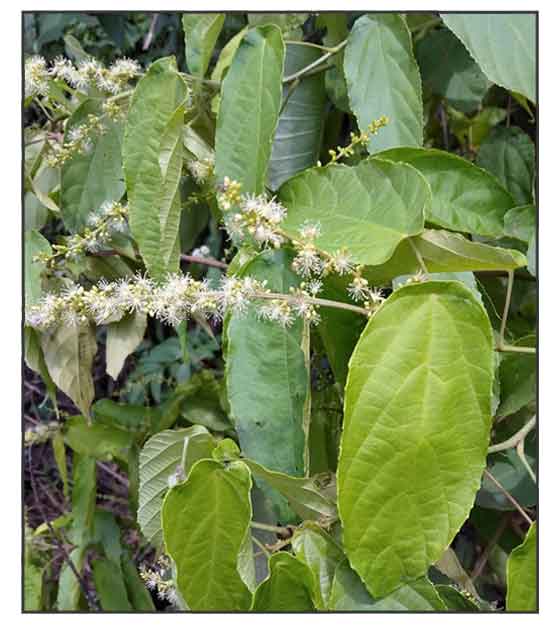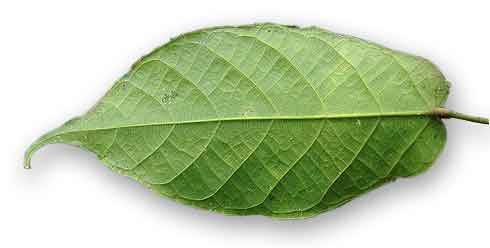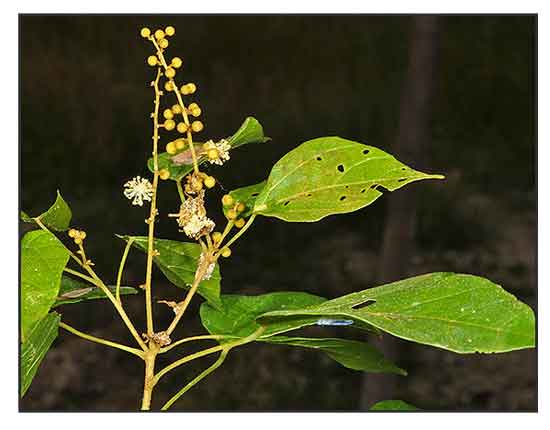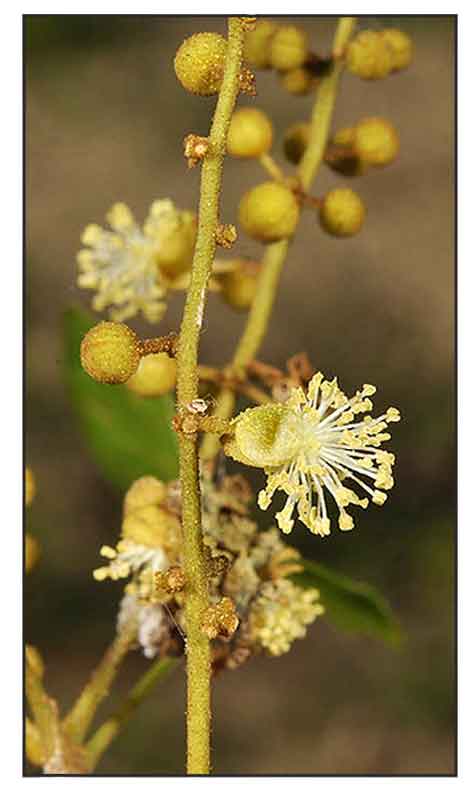Gen info
- Mallotus is a genus of the spurge family Euphorbiaceae, first described in 1790.
-
Mallotus peltatus is a species of flowering plant in the family Euphorbiaceae. It was first described by Eduard Ferdinand Geiseler in 1807 as Aleurites peltatus. (2)
- It was listed as "Vulnerable" in the 1998 IUCN Red list, where it was said to be native only to a single island in the Philippines. In February 2023, the species was included within Mallotus peltatus, which has a much wider distribution. (2)
 Botany Botany
• Shrubs or small trees, 2-8 m tall. Branchlets stellate-hirsute and pubescent. Leaves alternate, sometimes subopposite; stipules oblong, ca. 3 mm, deciduous; petiole 0.5-4.5 cm; leaf blade oblong-obovate or elliptic, 5-18 × 2-6 cm, papery, abaxially stellate-hirsute along midvein, sparsely yellowish glandular- scaly, base obtuse or narrowly cordate, sometimes peltate, with 4 basal glands, margin subentire or repand-denticulate, apex acuminate; lateral veins 8-10 pairs. Male inflorescences racemose, terminal, 6-12 cm; bracts ovate-lanceolate, 2-3 mm. Male flowers 2-5-fascicled; pedicel 2-3 mm; calyx lobes 3, ovate, ca. 1.5 mm, glabrous; stamens 25-45. Female inflorescences racemose, 5-8 cm, with 4-7 flowers; bracts subulate, ca. 2 mm. Female flowers: calyx urceolate, 5-7 mm, stellate-pubescent, 3-denticulate, spathaceous, deciduous; ovary densely puberulent and softly spiny; styles 3, ca. 8 mm, connate at middle, plumose. Capsule 3-locular, 14 mm in diam., pubescent and glandular- scaly, sparsely softly spiny; pedicel ca. 5 mm. Seeds globose, ca. 5 mm in diam., brown marbled. Fl. Feb-Jun, fr. Jun-Nov. (Flora of China)
Distribution
- Native to the Philippines.
- In lowland dry forests.
- Also native to
Bangladesh, Borneo, Cambodia, India, Jawa, Malaya, Maluku, Myanmar, New Guinea, Nicobar Is., Sulawesi, Sumatera, Thailand, Vietnam. (1)
 Constituents Constituents
- Crude methanol extract of leaves revealed presence of tannins, saponins. terpenoids, steroids, and reducing sugars, while n-butanol fractions revealed ursolic acid, beta-sitosterol, and some fatty acid compounds. (see study below)
(4)
- Phytochemical screening of leave yielded steroids, triterpenoids, flavonoids, reducing sugars, tannins, and saponins, with absence of alkaloids, amino acids, and gum. (see study below) (7)
Properties
- Dried material smells of fenugreek.
-
Studies have suggested antimicrobial, anti-inflammatory, hepatoprotective, antioxidant, antipyretic, lipid lowering, anti-Herpes virus properties.
 Parts used Parts used
Leaves, stem bark.
Uses
Edibility
- Berries are reportedly edible.
Folkloric
- No reported folkloric medicinal use in the Philippines.
- In various folk medicines, leaves and stem bark used for treatment of intestinal ailments, gallbladder disease, and skin infections.
- In India, used by tribal populations of Bay Islands for treatment of stomachache, intestinal ailments, and skin infections. Alcoholic extract of leaves used for trematodic infection. (4)
Studies
• Antimicrobial / Anti-Inflammatory / Leaves: Study of evaluated a crude methanolic extract of leaves for antimicrobial and anti-inflammatory activity. The extract was found active against Staphylococcus aureus, S. saprophyticus, Streptococcus faecalis, Bacillus subtilis, Escherichia coli, and Proteus mirabilis and the dermatophytic fungi Microsporum gypseum. MICs ranged from 128 to 2000 mcg/ml for bacteria and 128 mg/ml for fungi. The ME at 200 and 400 mg/kg and n-butanol fractions A and B at 25 mg/kg showed anti-inflammatory activity against carrageenan (acute model) and dextran-induced (subacute model) rat paw edema and cotton-pellet granuloma (chronic model) in rats, using indomethacin as standard. Antibacterial and anti-inflammatory activity was attributed to either fraction A (ursolic acid) alone or combination of fractions A and B (beta-sitosterol and fatty acids) of the extract. (see constituents above) (4)
• Antipyretic / Leaves: Study evaluated the anti-pyretic potential of methanol extract of M. peltatus var. acuminatus on normal body temperature and yeast-induced pyrexia in Wister albino rats. At doses of 100, 200, and 300 mg/kg p.o. the extract showed significant reduction in normal body temperature and yeast-provoked elevated temperature in a dose-dependent manner. The effect was comparable to standard anti-pyretic paracetamol (150 mg/kg p.o.). (5)
• Neuropharmacological Effects / Leaves: Study evaluated the neuropharmacological effects of methanol extract and fractions of M. peltatus var. acuminatus leaves in Wistar albino rats and Swiss albino mice. The crude extract at 200-300 mg/kg p.o. and fractions A and B at 50 mg/kg caused significant reduction in spontaneous activity (behavior profile), remarkable decrease in exploratory behavioral pattern (Y-maze and head dip tests), reduction in muscle relaxant activity (rotarod, 30° inclined screen and traction tests) and significantly potentiated phenobarbitone sodium-induced sleeping time. The crude leaf extract yielded tannin, triterpenoid, flavonoid, sterol, alkaloids, and reducing sugar. The psychopharmacological activity of the crude leaf extract appeared to be due to either fraction A (50 mg/kg) or a combination of fractions A and B, along with some fatty acids in the n-butanol part of the methanol extract of leaf. (6)
• Anti-Inflammatory / Antioxidant / Leaves: Study showed methanol extract of leaves possesses significant dose dependent anti-inflammatory and antioxidant activities at nontoxic concentrations. Terpenoid and ß-sitosterol, along with other minor constituents contributed to dose-dependent therapeutic efficacy. (see constituents above) (7)
• Hepatoprotective / Antioxidant / / H2O2-Induced Liver Injury / Polyphenols: The liver cells are susceptible to mitochondrial dysfunction due to external stimuli, excess ROS and redox imbalance. Study evaluated the protective effect of polyphenolic fractions of M. peltatus (MP) against H2O2-induced oxidative stress injury in hepatocytes. Effect was assessed by measures of survival rate, enzyme activities, intracellular ROS levels, cell apoptosis rate, mitochondrial membrane potential, and mRNA expression of related signaling pathways. The purified fractions contained different polyphenols (kaempferol 3-O-sophoroside, corilagin, and cirsiliol) and showed great antioxidant activities. MPMAP-1 alleviated L02 cells oxidative stress and hepatocellular injury induced by H2O2. Study highlighted the protective effects of MP polyphenols against H2O2-induced injury in L02 cells. Study provides specific preparation process and component analysis of the extract. Further research is needed to elucidate the molecular mechanisms and to explore the therapeutic applications of MP polyphenols in oxidative stress-related liver disease. (8)
 • Anti-Obesity: Study evaluated the antiobesity effect of Mallotus furetianus extract (MFE) on invivo and in vitro effects on lipid synthesis. Treatment with MFE significantly suppressed increase in body weight and adipose tissue weight and morphological changes in the liver and adipose tissue of obesity model mice. MFE treatmennt suppressed expression of transcription factors such as C/EBPα, C/EBPβ, and PPARγ, which are involved in early differentiation of 3T3-L1 preadipocytes. Thus, the ability to synthesize triacylglycerol was suppressed. Study clarified that MFE decreased expression of C/EBPß through post-translation modifications (PTMs), followed by transcriptional suppression of PPARγ and C/EBPα. (9) • Anti-Obesity: Study evaluated the antiobesity effect of Mallotus furetianus extract (MFE) on invivo and in vitro effects on lipid synthesis. Treatment with MFE significantly suppressed increase in body weight and adipose tissue weight and morphological changes in the liver and adipose tissue of obesity model mice. MFE treatmennt suppressed expression of transcription factors such as C/EBPα, C/EBPβ, and PPARγ, which are involved in early differentiation of 3T3-L1 preadipocytes. Thus, the ability to synthesize triacylglycerol was suppressed. Study clarified that MFE decreased expression of C/EBPß through post-translation modifications (PTMs), followed by transcriptional suppression of PPARγ and C/EBPα. (9)
• Anti-Herpes Virus: Study evaluated the antiviral potential of methanolic crude extract of M. peltatus, its active fraction and pure compound against HSV-1 F and HSV-2G. Results showed the bioactive fraction A and isolated ursolic acid has good anti-HSV activity, probably via inhibition of early stage of multiplication (post-infection of 0-5h), with SI value of 20, suggesting potential use as anti-HSV agent. (10)
• Potential Lipid Lowering Effect: Study purified three polyphenol fractions (MPMAP 1-3) from 60% ethanol extract of Mallotus pellatus Müll.Arg (MPMA) and evaluated them for hypolipidemic activities using an FFA-induced L02 cell model. Results showed significant inhibition of lipid accumulation, reduced intracellular MDA content, enhanced activities of CAT, SOD, and GPx in FFA-induced L02 cells The qRT-PCR results indicated regulation of fat accumulation in L02 cells by modulating expression of mRNA in Nrf2/ARE signaling pathway and lipid metabolism pathway. MPMAP-1 was able to reduce lipid accumulation and ROS levels and increased activities of enzymatic enzymes in C. elegans. Results suggest the polyphenol compounds of MPMA has potential as natural product for lipid lowering. (11)
Availability
- Wild-crafted.
|

![]()







